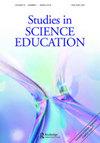构建科学教学中有效的教学解释框架
IF 9.9
2区 教育学
Q1 EDUCATION & EDUCATIONAL RESEARCH
引用次数: 24
摘要
教学解释有时被描述为一种无效的科学教学方式,代表了一种传递性的学习观。然而,科学教师经常提供教学解释,学生也在合作学习中提供。与关于解释的传递观点相反,研究表明,如果教学解释基于解释者和被解释者之间的互动,包括对理解和适应被解释者需求的诊断,那么教学解释可能是成功的。本文有三个目标:(1)提出了一个潜在有效教学解释的框架,提出了有效教学解释构成的五个核心思想,以及如何将其应用于科学教学的两个核心思想。(2) 为了证明该框架的合理性,本文将回顾关于教学解释有效性的研究。它将确定已经研究过的影响教学解释有效性的因素,并讨论它们在科学教学中的适用性。(3) 本文将把教学解释的研究与科学教学质量的基本维度联系起来。它将讨论核心思想作为教学质量基本维度的特定表达,特别是“认知激活”和“建设性支持”。本文章由计算机程序翻译,如有差异,请以英文原文为准。
Towards a framework for effective instructional explanations in science teaching
ABSTRACT Instructional explanations have sometimes been described as an ineffective way to teach science, representing a transmissive view of learning. However, science teachers frequently provide instructional explanations, and students also offer them in cooperative learning. Contrary to the transmissive view regarding explanation, studies suggest that instructional explanations might be successful if they are based on an interaction between explainers and explainees, including the diagnosis of understanding and adaptation to the explainee’s needs. The present article has three goals: (1) It will propose a framework for potentially effective instructional explanations, presenting five core ideas of what constitutes effective instructional explanations and two concerning how they should be implemented into science teaching. (2) To justify the framework, the article will review studies on the effectiveness of instructional explanations. It will identify factors that have been researched for their impact on the effectiveness of instructional explanations and discuss them for their applicability to science teaching. (3) This article will connect the research on instructional explanations with the idea of basic dimensions of instructional quality in science. It will discuss the core ideas as particular expressions of the basic dimensions of instructional quality, specifically ‘cognitive activation’ and ‘constructive support’.
求助全文
通过发布文献求助,成功后即可免费获取论文全文。
去求助
来源期刊

Studies in Science Education
EDUCATION, SCIENTIFIC DISCIPLINES-
CiteScore
15.30
自引率
2.00%
发文量
7
审稿时长
>12 weeks
期刊介绍:
The central aim of Studies in Science Education is to publish review articles of the highest quality which provide analytical syntheses of research into key topics and issues in science education. In addressing this aim, the Editor and Editorial Advisory Board, are guided by a commitment to:
maintaining and developing the highest standards of scholarship associated with the journal;
publishing articles from as wide a range of authors as possible, in relation both to professional background and country of origin;
publishing articles which serve both to consolidate and reflect upon existing fields of study and to promote new areas for research activity.
Studies in Science Education will be of interest to all those involved in science education including: science education researchers, doctoral and masters students; science teachers at elementary, high school and university levels; science education policy makers; science education curriculum developers and text book writers.
Articles featured in Studies in Science Education have been made available either following invitation from the Editor or through potential contributors offering pieces. Given the substantial nature of the review articles, the Editor is willing to give informal feedback on the suitability of proposals though all contributions, whether invited or not, are subject to full peer review. A limited number of books of special interest and concern to those involved in science education are normally reviewed in each volume.
 求助内容:
求助内容: 应助结果提醒方式:
应助结果提醒方式:


